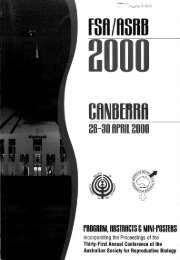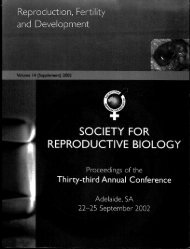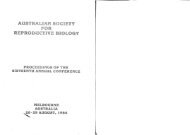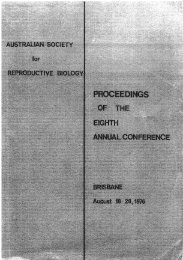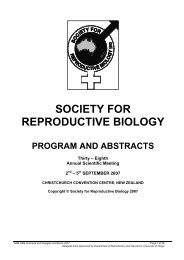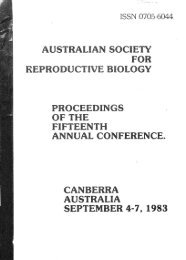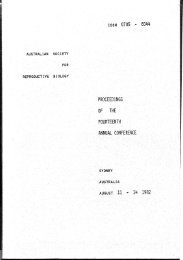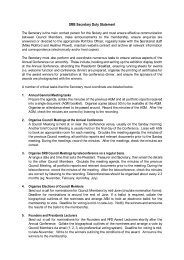n~po~ twenty-s i hth rnnurl conference - the Society for Reproductive ...
n~po~ twenty-s i hth rnnurl conference - the Society for Reproductive ...
n~po~ twenty-s i hth rnnurl conference - the Society for Reproductive ...
- No tags were found...
You also want an ePaper? Increase the reach of your titles
YUMPU automatically turns print PDFs into web optimized ePapers that Google loves.
CHARACTERIZATION OF IN VITRO SYNTHESIZED PROTEINS SECRETED BYPORCINE NON-ATTACHED OVIDUCTAL EPITHELIAL CELLSPHERES TREATED WITH ESTROGEN.Ping Xia, Jean Rutledge, Andrew J. Watson and David T. AnnstrongDept. of Obstetrics and GynaecoIogy, The University of Western Ontario, London, ON,Canada N6A 5A5INTRODUCTIONRecent studies by Buhi et a1. (1992) have demonstrated thatestrogen is responsible <strong>for</strong> induction ofde novo syn<strong>the</strong>sis andsecretion of certain oviductal secretory proteins (OSP) andinhibition of o<strong>the</strong>r OSP in porcine oviductal explant cultures. In<strong>the</strong> baboon (Boice 1990), sheep (Gandolfi 1991), hamster (Kan1988) and mouse (Kapur 1988), E:2-dependent oviductalglycoproteins contribute to <strong>the</strong> extracellular matrix of<strong>the</strong> embryoby associating with <strong>the</strong> zona pellucida and to <strong>the</strong> exclusivemicroenvironment of <strong>the</strong> embryo by entering <strong>the</strong> perivitellinespace. Studies in our laboratory have shown that E:2-treatedoviductal epi<strong>the</strong>lial cells facilitate early porcine embryonicdevelopment in vitro (Xia and Armstrong, 1994). The presentwork was undertaken to detect in vitro syn<strong>the</strong>sis of secretoryproteins by ~-treated porcine oviductal epi<strong>the</strong>lial cells used <strong>for</strong>coculture with early embryos.MATERIALS AND METHODSEpi<strong>the</strong>lial cell sheets were squeezed from ampullae of oviductsand cultured in TCM 199 with 10% FCS with or without E 2 (1~g/ml) <strong>for</strong> 48 hr, after which <strong>the</strong> oviductal cell aggregates<strong>for</strong>med epi<strong>the</strong>lial cell spheres (ECS). The ECSs (40 ECSs) werecultured in 200 ~I MEM without methionine containing 5 mg/mlglucose, 500 ~Ci/ml L)SS-Methionine and with or without E:2 (1~g/ml) under paraffin oil <strong>for</strong> 6 hr. The culture medium wasdialysed against 10 mM Tris-HCI buffer, pH 8.2, and deionizedwater. Dialysed culture medium (10,000 or 50,000 cpm) wasanalyzed by both ID- and 2D-SDS-PAGE.RESULTSThe results from ID-SDS-PAGE showed that <strong>the</strong> in vitrosyn<strong>the</strong>tic pattern of secretory proteins by ECS was altered by E 2treatment. These alterations included <strong>the</strong> appearance of onepolypeptide (33,000 Mr) and <strong>the</strong> disappearance of a secondpolypeptide (82,000 Mr) in <strong>the</strong> E:2-treated group, compared to <strong>the</strong>200-200-116-97-116-97- 66-82~tV 45-ctVC ~~45-31-33~31- 21-I I I2 3 4 7.6 7.0 6.0Figure 1. ID-SDS-PAGE.patterns observed <strong>for</strong> <strong>the</strong> controls. Additional proteins ofapproximate Mr 45,000 and 97,000 were increased in abundanceby E:2 treatment (Figure 1). Upon analyses by 2D-SDS-PAGE ofECS culture medium, <strong>the</strong> Mr 97,000 protein band was resolvedinto two acidic proteins of PI 4.5 and PI 5.1. The PI 5.1 proteinwas clearly suppressed in <strong>the</strong> ~-treated group (arrow 7) whereas<strong>the</strong> PI 4.5 protein was increased by E:2 treatment (arrow 8). TheMr 45,000 protein complex in <strong>the</strong> ~-treated group was resolvedinto three acidic proteins, Mr 45,000 and 43,000, both with PI 5.5(arrow 4,5) and a Mr 36,000-45,000 protein complex with PI 4.8(arrow 6). Two basic proteins with PI 8.0 (Mr 36,000) (arrow 1)and PI 6.8 (Mr 25,000) (arrow 3) were both inhibited by E:2treatment. Ano<strong>the</strong>r protein (Mr 25,000, PI 7.6) was increased in<strong>the</strong> E:2-treated group (arrow 2).CONCLUSIONIn vitro syn<strong>the</strong>tic patterns of secretory proteins by porcineoviductal epi<strong>the</strong>lial cells used <strong>for</strong> embryonic coculture areinfluenced by E:2 treatment.REFERENCESBuhi WC et aI., 1992 J Exp ZooI262:426-435.Boice ML et aI., 1990 Bioi Reprod 43:340-346.Gandolfi C et aI., 1991 Eur J Basic Appl Histochem 35:383-392.Kan FWK, (1988) J Histochem Cytochem 36:1441-1447.Kapur RP and Johnson LV (1988) Anat Rec 221:720-729.Xia P and Armstrong DT (1994) Therigenology 41 :340.Figure 1: 1. ECS conditioned medium, control.2. E:2-treated ECS conditioned medium.3. ECS, control.4. E:2-treated ECS.Figure 2: A: ECS conditioned medium, control.B: E:2-treated ECS conditioned medium.Figure 2. 2D-SDS-PAGE11'1 A2 3I I I L5.1 4.5 7.6 7.0pHI6.0IBI5.1 4.5-CRYOPRESERVATION OF HUMAN SPERM WITH PENTOXIFYLLINEMonash IVF, 185 RoddIe Street, Richmond, Victoria 3121INTRODUCTIONAddition of 3mM pentoxifylline (PF), a cyclicadenosine 3'-5'-monophosphate (cAl\.1P) phosphodiesteraseinhibitor, to cryoprotectant has been shownto increase recovery of motile sperm post-thaw (1).This improvement may be due to (i) increasedintracellular cAl\.1P levels and direct stimulation ofmotility or (ii) PF acting as an antioxidant <strong>the</strong>rebyreducing membrane damage associated with <strong>the</strong>fr~eze-thaw process. We have previously shown thatmotility and normal acrosome morphology (AM) aresignificantly reduced by cryopreservation and thatdecreases in normal AM may be due to cell death or tosubletllal damage including membrane disruption (2).The aim of this study was to investigate <strong>the</strong> effect ofPF on sperm during cryopreservation and to assess itspotential usefulness in improving <strong>the</strong> recovery offunctional sperm post-thaw.MATERIALS AND METHODSSemen samples from donors (n=15) with normalsemen characteristics (WHO, 1992) were assessed <strong>for</strong>progressive and total motility and AM. Motility wasassessed on a warm-stage-equipped phase contrastmicroscope. AM was assessed by labelling ethanolfixed sperm with fluorescein-conjugated concanavalinA lectin (2). Samples were diluted 1: 1 with HumanSperm Preservation Medium (3) and divided into 4aliquots to which PF was added to <strong>the</strong> following finalconcentrations; 0 (control), 1, 3 and 10mM. Thesealiquots were mixed, aspirated into O.5m1 straws,frozen in liquid N 2 vapour and stored in liquid N 2 •Samples were thawed at 25°C <strong>for</strong> 10 minutes <strong>for</strong> reassessmentofmotility and AM which were reported asa percentage of<strong>the</strong>ir initial values (mean±sem).RESULTSPost-thaw progressive motility was found to beincreased in <strong>the</strong> presence of all concentrations of PFcompared to control (Fig. I). However, this increasewas only significant (p



